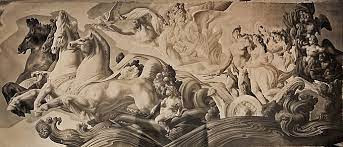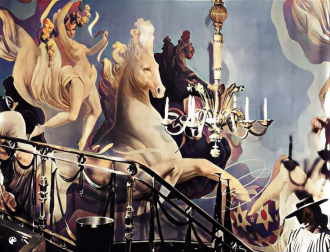Andre Durenceau's "Neptun"
"Neptun" by André Durenceau.
Mural aboard America in 1940.
This six-meter (20 feet)-wide mural is devoted entirely to the mythology of the seas. You can see the sea god Neptune and his wife Amphitrite riding over the waves in a chariot drawn by four horses. Several water nymphs (nereids) follow the quadriga in the background. Also seen are the four winds, which according to the legend, Neptune threatened after they attacked the fleet of Aeneas in the name of his sister Juno and thus put his absolute power into question.
The scenery is mostly done in red and silver and reflects the predominant colors chosen for the ballroom.
whereabouts of artwork: This mural was carelessly stored in 1941 after being removed from the ship during the USS West Point conversion. After the war it was in very bad condition and couldn't be restored. It was replaced in 1946 by the mural "The Circus" by Charles Baskerville.
"Abiquiu"- mural in 3. class lounge by Fremont F. Ellis.
Fremont F. Ellis, New Mexican artist, draws the inspiration for his mural in the 3. class lounge from his native Southwest. The canvas depicts the village of Abiquiu. It was originally founded by Spanish colonists, later occupied by the Ute tribe and rebuilt in 1754 by settlers.
whereabouts of artwork: Most likely removed in 1961 during the conversion of America in a two class ship. The 3. class lounge was converted into tourist class cinema.
New York Syline by Pierre Bourdelle.
A painting of the New York skyline by Pierre Bourdelle was decorating the foyer of the first class dining room on A-deck.
Unfortunately no photograph of this wall relief done in the same style as Bourdelle's work in the first class dining room could be found. The picture on the left is a greatly enlarged section of an image of the first class dining room on which parts of the wall relief are visible through the glass windows of the entrance doors. On the right side appears to be the stylized Empire State Building and through the left window you can see more skyscrapers and possibly the supporting cables of a bridge.
Nothing known about the whereabouts.
(If someone wants to share a better image of this artwork, I would be happy to replace it.)
Oil painting of the spanish settlement Abiquiu aboard America.
André Durenceau working on Neptun- mural.
about the artist: When André Maurice Durenceau (1904 - 1985) created his mural "Neptune" for the ballroom of America in late 1939, he was 34 years old and already at the peak of his career. In the same year he had already performed contract work for the World's Fair in New York.
Born in Auray (France) Durenceau emigrated to the United States when he was 24 years old. He earned his living as a color consultant for the then new Technicolor process for color films in Hollywood. During this time he was also hired for his first major commissions. Soon he was called "the best contemporary muralist of the century" in distinguished art circles. His use of color and shapes was very courageous and open-minded. He himself didn't think of his talent as a miracle but as the product of hard work. Durenceau as quoted in a newspaper article: "You must work. You cannot be an artist in five years. A lifetime is better. You must know the fundamentals. That is the trouble with so many modern artists- they start crazy. You must start traditional- and then branch off. [...] Modern art is all a mess. But it is a good mess. You know what I mean?"
Mural aboard America in 1940.
This six-meter (20 feet)-wide mural is devoted entirely to the mythology of the seas. You can see the sea god Neptune and his wife Amphitrite riding over the waves in a chariot drawn by four horses. Several water nymphs (nereids) follow the quadriga in the background. Also seen are the four winds, which according to the legend, Neptune threatened after they attacked the fleet of Aeneas in the name of his sister Juno and thus put his absolute power into question.
The scenery is mostly done in red and silver and reflects the predominant colors chosen for the ballroom.
whereabouts of artwork: This mural was carelessly stored in 1941 after being removed from the ship during the USS West Point conversion. After the war it was in very bad condition and couldn't be restored. It was replaced in 1946 by the mural "The Circus" by Charles Baskerville.
"Abiquiu"- mural in 3. class lounge by Fremont F. Ellis.
Fremont F. Ellis, New Mexican artist, draws the inspiration for his mural in the 3. class lounge from his native Southwest. The canvas depicts the village of Abiquiu. It was originally founded by Spanish colonists, later occupied by the Ute tribe and rebuilt in 1754 by settlers.
whereabouts of artwork: Most likely removed in 1961 during the conversion of America in a two class ship. The 3. class lounge was converted into tourist class cinema.
New York Syline by Pierre Bourdelle.
A painting of the New York skyline by Pierre Bourdelle was decorating the foyer of the first class dining room on A-deck.
Unfortunately no photograph of this wall relief done in the same style as Bourdelle's work in the first class dining room could be found. The picture on the left is a greatly enlarged section of an image of the first class dining room on which parts of the wall relief are visible through the glass windows of the entrance doors. On the right side appears to be the stylized Empire State Building and through the left window you can see more skyscrapers and possibly the supporting cables of a bridge.
Nothing known about the whereabouts.
(If someone wants to share a better image of this artwork, I would be happy to replace it.)
Oil painting of the spanish settlement Abiquiu aboard America.
André Durenceau working on Neptun- mural.
about the artist: When André Maurice Durenceau (1904 - 1985) created his mural "Neptune" for the ballroom of America in late 1939, he was 34 years old and already at the peak of his career. In the same year he had already performed contract work for the World's Fair in New York.
Born in Auray (France) Durenceau emigrated to the United States when he was 24 years old. He earned his living as a color consultant for the then new Technicolor process for color films in Hollywood. During this time he was also hired for his first major commissions. Soon he was called "the best contemporary muralist of the century" in distinguished art circles. His use of color and shapes was very courageous and open-minded. He himself didn't think of his talent as a miracle but as the product of hard work. Durenceau as quoted in a newspaper article: "You must work. You cannot be an artist in five years. A lifetime is better. You must know the fundamentals. That is the trouble with so many modern artists- they start crazy. You must start traditional- and then branch off. [...] Modern art is all a mess. But it is a good mess. You know what I mean?"
Date & Place:
Not specified or unknown.


 Amanda S. Stevenson
Amanda S. Stevenson 



